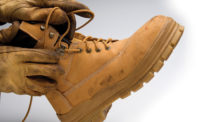In search of the right safety footwear
In our production/process areas employees work 8-12 hour shifts and are often on their feet continuously. Due to the fire hazard, we require chemically protective safety shoes or boots. For many years, our shoe requirements were satisfied primarily by using a six-inch black rubber safety toe shoe, a relatively inexpensive six-inch PVC sole boot (primarily for contractors) and a 14-inch PVC sole knee boot. We purchased these boots directly from a supplier we’ll call "Manufacturer A" (names withheld for confidentiality) with a national contract. We later began ordering Manufacturer A’s shoes through a safety supply vendor shelving program in 1991.
Challenge #1
Our first challenge came in 1990 when our plant built a hydrogen peroxide (also an oxidizer) production facility. Part of the process utilizes a petroleum hydrocarbon solvent. Not only did the solvent create a slippery walking surface, but it also slightly dissolved the soles on the black rubber boots, leaving black streaks that presented a housekeeping problem. Employees were prohibited from using this shoe because of lack of chemical compatibility.We tried the six-inch PVC sole boots, which turned out to be more chemically compatible but created comfort problems. The hard soles were tough to wear 8-12 hours a day, especially when walking on concrete and going up and down ladders, platforms, and stairways. Insoles helped some but not enough.
The PVC-polyurethane blend sole knee boot wasn’t the answer, either. It had to be cut off for day-to-day use, and it didn’t come in smaller women’s sizes. We had no luck with other manufacturers’ lines. In 1993, some of the hydrogen peroxide production employees, including their safety committee member, came up with a good idea -- a lightweight, comfortable, compatible, custom-made boot made of Gore-Tex uppers and PVC blended soles. But the manufacturer sales reps told us that we had to buy thousands of pairs to meet production quotas.
A year later we tried a PVC nitrile blend sole boot that was chemically compatible with the working solution. Produced as knee boots, the manufacturer and vendor agreed to cut them off so they could be worn as a six-inch boot for every day use. Our safety supply vendor recommended that we standardize the use of this boot since it was chemically compatible with both the sodium chlorate and hydrogen peroxide processes, and our plant safety committee voted to do so.
Challenge #2
Our second challenge occurred in 1992 when Manufacturer A switched to a production facility that had different size shoe molds, meaning that the black rubber shoes that satisfied most employees were now too narrow and uncomfortable. We switched to Manufacturer B’s black rubber shoe which was wider, but still not as comfortable as A’s previous shoe. The price remained about the same.Two years later we found greater comfort in B’s six-inch basketball sole shoes, which we call Frankenstein shoes. But comfort came with a risk -- using Frankenstein shoes to climb ladders presented a slip hazard due to the lack of a heel on the shoe. There was no product warning on the shoe box. Our supplier said that Manufacturer B was aware of the potential danger but would not issue a product warning. Regrettably, we had to recall the shoes and our safety supply vendor took them back.
Challenge #3
In 1994 we discovered that some of the six-inch black rubber, lace-up shoes had a fabric covering on the tongue which would soak up sodium chlorate and, when dry, would ignite when exposed to an ignition source. We checked with the other manufacturers of black rubber boots but each one had fabric cloth covering on the tongue. Our plant safety committee decided to continue to use the boots with a warning to each employee to make sure they kept them clean and free of contamination by sodium chlorate.Challenge #4
Cold weather provided the next challenge. Our standard chemically protective safety toe shoes are not insulated against cold weather and employees who worked outside on concrete, especially during long shifts, complained of frozen feet. We looked at snow ski boot inserts, insulated boots, and two layers of socks as some duck hunters use. (There are insulated safety toe boots but they are made of rubber and are not compatible with the petroleum solvent we use.)Our safety committee settled on a PVC overshoe worn over a steel-toe insulated hunting boot provided by employees themselves. These were to be worn when fire watching or performing other less hazardous operations where the potential for oxidizer contamination was minimal. Employees working in production areas still had to wear their regular safety toe shoes.
Challenge #5
Our most recent challenge occurred in 1995 when we learned that one line of boots we provided was uncomfortable to employees with high arches. They had trouble getting the boots on because the boots were not open on the upper side, like a boot with a tongue. Splitting the boots down the top made it possible to get them on but jeopardized their ability to protect.Last year we contacted our safety supply vendor to help find a suitable boot or shoe. We again involved our safety committee members, including a special shoe selection subcommittee, which met with the safety supply vendor and manufacturers’ sales representatives. Through trial and error and after seeing many styles, the group recommended a boot that was lightweight, chemically compatible, and made of a high molecular-weight PVC compound with a flexible, slip-resistant sole. The only drawback was that the sole’s flexibility was not the best for walking across several large rock gravel areas in the plant.
Once we decided to inventory this boot we had to take bids from various suppliers to comply with our purchasing requirements. Two local vendors who had help from the manufacturer’s sales representative in the area were allowed to bid. They both were able to undercut our main safety supply vendor who had worked so hard to help us get the right boot. Regrettably, we went with the lowest bidder because it would be difficult to justify the cost difference.
Now we’ve gone through the process of setting up the boots in a safety supply consignment inventory. Is our search complete? We think so for now, but only time will tell.
Looking for a reprint of this article?
From high-res PDFs to custom plaques, order your copy today!





